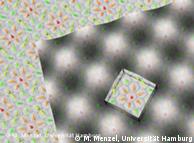Quasiparticle discovery could pave the way for better digital storage

Skyrmions were found on an atomic layer of iron on iridium
German scientists from Jülich, Kiel and Hamburg have found a new
magnetic order that could potentially lead to a new generation of
smaller data storage units in the future.
Physicists from the Jülich research center and the universities
of Kiel and Hamburg have found a regular lattice of stable magnetic
skyrmions – radial spiral structures, which are made up of atomic-scale
spins.
These magnetic patterns have been found in large bulk materials
before, but never on a nano-sized surface. The team of scientists,
which published their findings Sunday in the journal Nature Physics,
have theorized that these magnetic structures could lead to smaller and
more efficient data storage units.
"If you had asked me five years ago if such a structure can form, I
would have said no. But nature has its surprises," said Stefan Blügel,
director of the Institute of Quantum Theory of Materials at the Peter
Grünberg Institute at the Jülich national laboratory, and one of the
paper's co-authors.
"We've discovered a new magnetic structure that is an extremely
stable one," he told Deutsche Welle. "This structure is
topologically-protected, and can't be destroyed very easily."
The future of spintronics
Skyrmions were first postulated by a British physicist in the 1950s,
but were not found in nature until decades later. Physicists have
speculated that these quasiparticles might assist the burgeoning
research area of spintronics, which may power the next generation of
consumer gadgets.
This new area physics research is being hailed as the successor of
conventional electronics, based on transistor and semiconductor
technology. In general, for over the last 50 years, the number of
transistors that can be put on an integrated circuit doubles
approximately every 18 to 24 months.
However, the number of transistors is now getting so large, on such a
small space, that it's beginning to hit its physical limits, and will
soon reach the size of individual atoms.
 The new findings might lead to smaller and more efficient storage unitsConventional
electronics have been based on harnessing the charge of electrons. When
they move, they generate electric current, which can be used to
transfer information. But electrons can do more than just travel in a
linear direction - one quantum-mechanical characteristic is their
intrinsic spin. Just as an ice skater twirls, so too do electrons. The new findings might lead to smaller and more efficient storage unitsConventional
electronics have been based on harnessing the charge of electrons. When
they move, they generate electric current, which can be used to
transfer information. But electrons can do more than just travel in a
linear direction - one quantum-mechanical characteristic is their
intrinsic spin. Just as an ice skater twirls, so too do electrons.
Spintronics makes use of both the intrinsic spin of the electron and
its fundamental electronic charge. In theory, scientists say that by
harnessing this electronic spin as a way to store data at high-speed and
low-power. Conceivably, that could make internal batteries, or even
booting up a device, completely unecessary.
Earlier research in spintronics paved the way for solid-state flash
memory commonly found nowadays in smartphones and digital cameras.
In the new study, the German scientists found the skyrmions in a thin
layer of iron on iridium, where each spiral was made up of just 15
atoms.
Skyrmions on the surface
"It's extraordinary, because we found it on a surface instead of in bulk materials," Blügel said.
In 2009, scientists from Munich had found a similar structure in bulk
materials, but this new one is 10 times smaller than that previous
discovery.
"But it's a lot easier to observe and manipulate a magnetic structure
on a surface, to write the codes 0 and 1 on the layer," Blügel adds.
 Newer laptops have flash memory instead of traditional hard drives"For us, it was surprising that this kind of structure formed after all, and that it was so very small," Blügel said. Newer laptops have flash memory instead of traditional hard drives"For us, it was surprising that this kind of structure formed after all, and that it was so very small," Blügel said.
Other phycisists have been impressed by the new finding.
"It's definitely meaningful for the field of magnetism," said Markus
Garst who participated in the 2009 study, but didn't contribute to the
recent study. "It's important that skyrmions were found in a different
material as well. It's important for fundamental research and proves
that these findings were not just an exotic exception."
Computer users will have to wait a bit longer
According to Ulrich Rössler from the Leibniz Institute for Solid
State and Materials Research in Dresden, who has been researching these
magnetic spirals for some time, these recent findings will mean that a
new field of research may emerge, he wrote in an e-mail sent to Deutsche
Welle.
"Such conditions consisting of countable units are quite rare in physics," he wrote.
But Rössler also added that it's too early to say how soon these findings can be put to use.
Blügel, one of the paper's authors, agreed, saying that it may be at
least a decade before this research bears out into actual
consumer products.
"This is important for storage as resistance comes into play when
reading data," he said. "Maybe in about 10 to 15 years, this can be put
to use in smaller storage units that can hold more data."
Author: Sarah Steffen
Editor: Cyrus Farivar
ttp://www.dw-world.de/dw/article/0,,15285806,00.html
| 








